人骨肉瘤耐阿霉素细胞模型的建立及其生物学特性(精)
- 格式:doc
- 大小:177.50 KB
- 文档页数:24
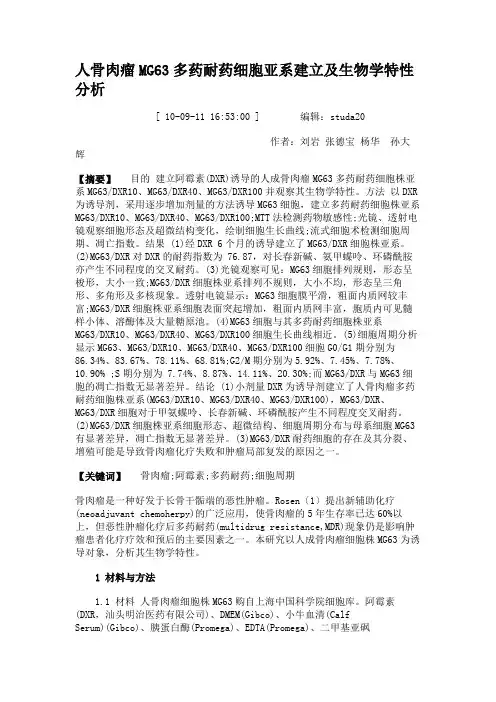
人骨肉瘤MG63多药耐药细胞亚系建立及生物学特性分析[ 10-09-11 16:53:00 ] 编辑:studa20作者:刘岩张德宝杨华孙大辉【摘要】目的建立阿霉素(DXR)诱导的人成骨肉瘤MG63多药耐药细胞株亚系MG63/DXR10、MG63/DXR40、MG63/DXR100并观察其生物学特性。
方法以DXR 为诱导剂,采用逐步增加剂量的方法诱导MG63细胞,建立多药耐药细胞株亚系MG63/DXR10、MG63/DXR40、MG63/DXR100;MTT法检测药物敏感性;光镜、透射电镜观察细胞形态及超微结构变化,绘制细胞生长曲线;流式细胞术检测细胞周期、凋亡指数。
结果 (1)经DXR 6个月的诱导建立了MG63/DXR细胞株亚系。
(2)MG63/DXR对DXR的耐药指数为 76.87,对长春新碱、氨甲蝶呤、环磷酰胺亦产生不同程度的交叉耐药。
(3)光镜观察可见:MG63细胞排列规则,形态呈梭形,大小一致;MG63/DXR细胞株亚系排列不规则,大小不均,形态呈三角形、多角形及多核现象。
透射电镜显示:MG63细胞膜平滑,粗面内质网较丰富;MG63/DXR细胞株亚系细胞表面突起增加,粗面内质网丰富,胞质内可见髓样小体、溶酶体及大量糖原池。
(4)MG63细胞与其多药耐药细胞株亚系MG63/DXR10、MG63/DXR40、MG63/DXR100细胞生长曲线相近。
(5)细胞周期分析显示MG63、MG63/DXR10、MG63/DXR40、MG63/DXR100细胞G0/G1期分别为86.34%、83.67%、78.11%、68.81%;G2/M期分别为5.92%、7.45%、7.78%、10.90% ;S期分别为 7.74%、8.87%、14.11%、20.30%;而MG63/DXR与MG63细胞的凋亡指数无显著差异。
结论 (1)小剂量DXR为诱导剂建立了人骨肉瘤多药耐药细胞株亚系(MG63/DXR10、MG63/DXR40、MG63/DXR100),MG63/DXR、MG63/DXR细胞对于甲氨蝶呤、长春新碱、环磷酰胺产生不同程度交叉耐药。
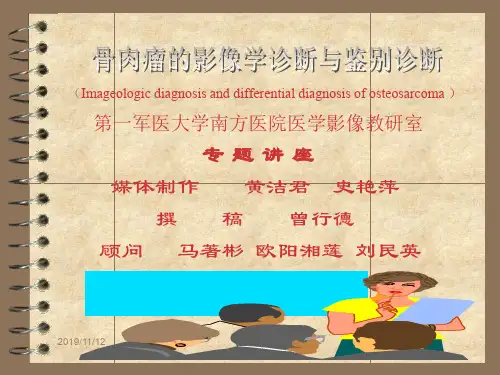
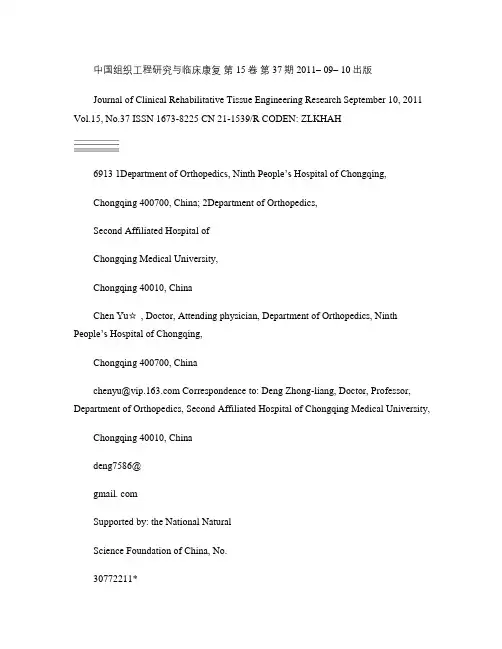
中国组织工程研究与临床康复第 15卷第 37期 2011– 09– 10出版Journal of Clinical Rehabilitative Tissue Engineering Research September 10, 2011 Vol.15, No.37 ISSN 1673-8225 CN 21-1539/R CODEN: ZLKHAH6913 1Department of Orthopedics, Ninth People’s Hospital of Chongqing,Chongqing 400700, China; 2Department of Orthopedics,Second Affiliated Hospital ofChongqing Medical University,Chongqing 40010, ChinaChen Yu☆ , Doctor, Attending physician, Department of Orthopedics, Ninth People’s Hospital of Chongqing,Chongqing 400700, Chinachenyu@ Correspondence to: Deng Zhong-liang, Doctor, Professor, Department of Orthopedics, Second Affiliated Hospital of Chongqing Medical University,Chongqing 40010, Chinadeng7586@gmail. comSupported by: the National NaturalScience Foundation of China, No.30772211*Received: 2011-06-10 Accepted: 2011-07-30人骨肉瘤耐阿霉素细胞模型的建立及其生物学特性 *☆陈渝 1,王大勇 1,翁政 1,邓忠良 2Establishment of adriamycin-resistant human osteosarcoma cell line and research on its biological characteristicsChen Yu1, Wang Da-yong1, Weng Zheng1, Deng Zhong-liang2AbstractBACKGROUND: Multidrug resistance is a major factor leading to the failure of chemotherapy for human osteosarcoma. However,the precise mechanism remains poorly understood.OBJECTIVE: To establish adriamycin-resistant human osteosarcoma cell line143B/ADM and to analyze its biological characteristics.METHODS: Increasing concentrations of adriamycin (ADM were applied for 45 days to establish 143B/ADM resistant strain. Thehalf of inhibiting concentrations (IC50 and resistance indexs (RI of different antitumor drugs were measured by CCK assay, andthe cell cycle was analyzed by flow cytometry. The cellular efflux capacity was estimated by rhodamine test. After the cell lineswere treated by ADM, intracellular ADM concentration was detected by fluorospectrophotometer, and the apoptosis wasobserved by laser scanning confocal microscope and flow cytometry. Meanwhile, the expression of multidrug resistance 1(MDR-1, multidrug resistance-associated protein 1 (MRP-1 and lung resistance protein (LRP were detected by western blotanalysis.RESULTS AND CONCLUSION: After induction for 45 days, the RI of 143B/ADM cells to ADM was 15.7, and the 143B/ADM cellsshowed various resistances to cisplatin, methotrexate, isophosphamide, vincristine and taxinol. Compared with 143B/WT cell line,there were less cells in G2/M phase and more cells in G1 and S phases, markedly decreased intracellular rho123 and ADM in143B/ADM cell line (P < 0.01. Flow cytometry and confocal laser microscopy analysis showed that at 72 hours after treatmentwith ADM (10 mg/L, cell apoptosis in 143B/ADM cells was less than that in143B/WT cells. Furthermore, compared with143B/WT, the MDR-1 expression of 143B/ADM was increased significantly with no difference of MRP-1 and LRP expressionamong both cell lines. Multidrug resistance of 143B/ADM cells is related to MDR-1, and has no relationship with MRP-1 and LRP.Chen Y, Wang DY, Weng Z, Deng ZL.Establishment of adriamycin-resistant human osteosarcoma cell line and research on itsbiological characteristics. Zhongguo Zuzhi Gongcheng Yanjiu yu Linchuang Kangfu. 2011;15(37: 6913-6918.[ ]摘要背景:多药耐药是骨肉瘤化疗失败的重要原因,目前其耐药机制不明。
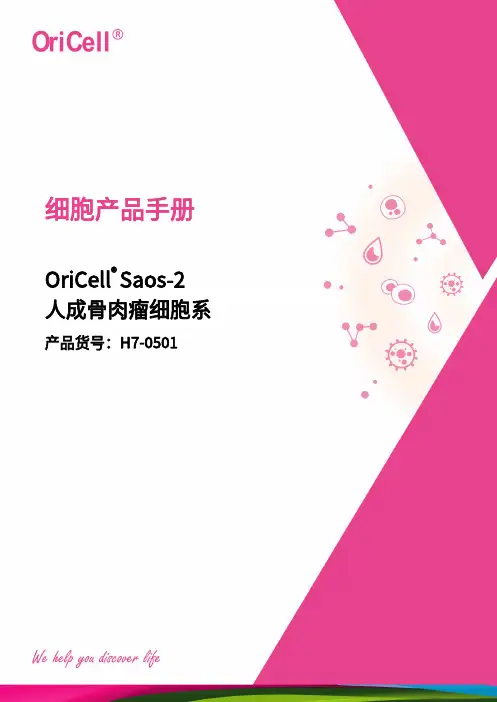
细胞产品手册OriCell®Saos-2人成骨肉瘤细胞系产品货号:H7-0501人成骨肉瘤细胞系(Saos-2)是一种具有上皮形态的细胞系,从一名11岁白人女性骨肉瘤患者的骨骼中分离出来,患者接受RTG、甲氨蝶呤、阿霉素、长春新碱、细胞毒和阿拉霉素-C治疗。
Saos-2细胞系的科研应用广泛,常用于3D细胞培养的研究。
注意:本产品仅提供给进一步科研使用,不可用于临床治疗等其他用途。
产品信息产品名称人成骨肉瘤细胞系简称Saos-2货号H7-0501规格1×106个/管或1×106个/瓶组织来源人骨细胞特性贴壁生长;上皮样培养条件95%空气;5%CO2;37℃培养基McCoy's5A+15%FBS倍增时间24~48h生物安全等级1保存条件液氮(-196℃)注意:本产品在生产过程中严格控制无菌。
在后续培养过程中,请根据实际情况决定是否在培养基中添加抗生素。
OriCell®Saos-2细胞系在倒置相差显微镜下的形态●通过细菌、真菌、支原体、内毒素检测。
●通过细胞复苏活力检测,复苏存活率>90%。
●通过STR检测。
详情见《产品检测报告》。
处理原则1.严格的无菌环境。
务必保证实验室整体、超净台和培养箱的清洁。
2.规范的操作方式。
请按照产品说明书描述的方式操作,严格控制变量,做好对照实验。
3.需要合适的、质量可靠的实验耗材和试剂。
本产品需使用适合贴壁细胞生长的培养容器,且不建议重复使用。
使用的试剂必须经验证可靠,适宜细胞生长且批间差异小。
注意:本产品冻存液中含有DMSO,其具有潜在风险,请谨慎处理。
本产品说明书中使用的试剂简写规则如下:FBS:Fetal Bovine Serum胎牛血清NBCS:Newborn Calf Serum新生牛血清BCS:Bovine Calf Serum小牛血清HS:Horse Serum马血清Glu:Glutamine谷氨酰胺ITS:Insulin、Transferrin、Selenite胰岛素、转铁蛋白、亚硒酸添加物NEAA:Non Essential Amino Acid非必须氨基酸SP:Sodium Pyruvate丙酮酸钠β-mer:β-mercaptoethanolβ-巯基乙醇Dex:Dexamethasone地塞米松P/S:Penicillin-Streptomycin青霉素-链霉素(双抗)细胞的复苏和培养所需材料®Saos-2细胞●OriCell●适宜细胞生长的完全培养基操作步骤注意:收到的细胞如24h内复苏,可存放于-80℃冰箱;超过24h请存放于液氮中,复苏前10min取出,放于-80℃,让管中液氮挥发。
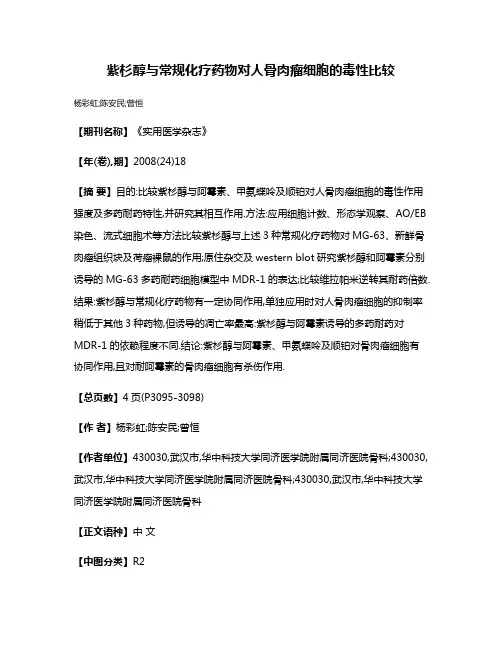
紫杉醇与常规化疗药物对人骨肉瘤细胞的毒性比较杨彩虹;陈安民;曾恒【期刊名称】《实用医学杂志》【年(卷),期】2008(24)18【摘要】目的:比较紫杉醇与阿霉素、甲氨蝶呤及顺铂对人骨肉瘤细胞的毒性作用强度及多药耐药特性,并研究其相互作用.方法:应用细胞计数、形态学观察、AO/EB 染色、流式细胞术等方法比较紫杉醇与上述3种常规化疗药物对MG-63、新鲜骨肉瘤组织块及荷瘤裸鼠的作用;原住杂交及western blot研究紫杉醇和阿霉素分别诱导的MG-63多药耐药细胞模型中MDR-1的表达;比较维拉帕米逆转其耐药倍数.结果:紫杉醇与常规化疗药物有一定协同作用,单独应用时对人骨肉瘤细胞的抑制率稍低于其他3种药物,但诱导的凋亡率最高:紫杉醇与阿霉素诱导的多药耐药对MDR-1的依赖程度不同.结论:紫杉醇与阿霉素、甲氨蝶呤及顺铂对骨肉瘤细胞有协同作用,且对耐阿霉素的骨肉瘤细胞有杀伤作用.【总页数】4页(P3095-3098)【作者】杨彩虹;陈安民;曾恒【作者单位】430030,武汉市,华中科技大学同济医学院附属同济医院骨科;430030,武汉市,华中科技大学同济医学院附属同济医院骨科;430030,武汉市,华中科技大学同济医学院附属同济医院骨科【正文语种】中文【中图分类】R2【相关文献】1.化疗药物对体外培养OS-732人成骨肉瘤细胞凋亡及细胞周期的影响 [J], 张文武;袁玮;刘一2.灵芝总三萜与紫杉醇或与顺铂在对人源肿瘤细胞的细胞毒性中的相互作用 [J], 岳庆喜;关树宏;谢付波;宋肖依;马超;冯利兴;刘璇;果德安3.多西紫杉醇协同卡铂对骨肉瘤细胞MG-63细胞毒性的实验研究 [J], 谭泽恩;董乐乐;;4.紫杉醇对人骨肉瘤细胞凋亡及对bcl-2、bax基因表达的影响 [J], 张春林;曾炳芳;董扬;张长青;眭述平;罗从风;陆男吉;高峰5.多西紫杉醇联合顺铂对人骨肉瘤细胞的增殖抑制作用 [J], 陶海;蔡林;宋健因版权原因,仅展示原文概要,查看原文内容请购买。
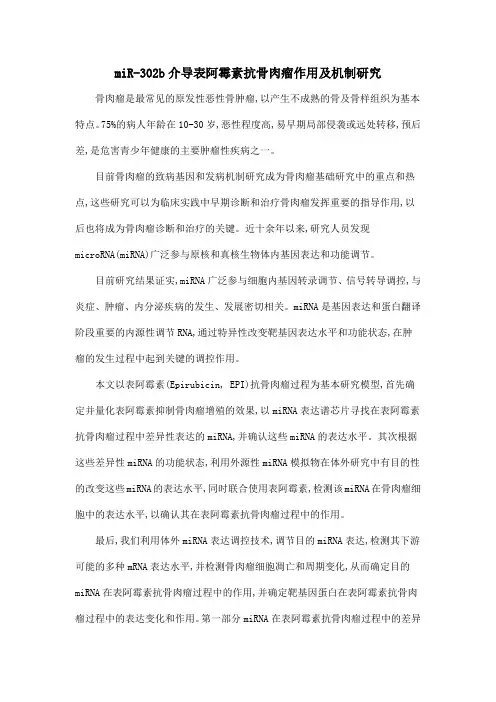
miR-302b介导表阿霉素抗骨肉瘤作用及机制研究骨肉瘤是最常见的原发性恶性骨肿瘤,以产生不成熟的骨及骨样组织为基本特点。
75%的病人年龄在10-30岁,恶性程度高,易早期局部侵袭或远处转移,预后差,是危害青少年健康的主要肿瘤性疾病之一。
目前骨肉瘤的致病基因和发病机制研究成为骨肉瘤基础研究中的重点和热点,这些研究可以为临床实践中早期诊断和治疗骨肉瘤发挥重要的指导作用,以后也将成为骨肉瘤诊断和治疗的关键。
近十余年以来,研究人员发现microRNA(miRNA)广泛参与原核和真核生物体内基因表达和功能调节。
目前研究结果证实,miRNA广泛参与细胞内基因转录调节、信号转导调控,与炎症、肿瘤、内分泌疾病的发生、发展密切相关。
miRNA是基因表达和蛋白翻译阶段重要的内源性调节RNA,通过特异性改变靶基因表达水平和功能状态,在肿瘤的发生过程中起到关键的调控作用。
本文以表阿霉素(Epirubicin, EPI)抗骨肉瘤过程为基本研究模型,首先确定并量化表阿霉素抑制骨肉瘤增殖的效果,以miRNA表达谱芯片寻找在表阿霉素抗骨肉瘤过程中差异性表达的miRNA,并确认这些miRNA的表达水平。
其次根据这些差异性miRNA的功能状态,利用外源性miRNA模拟物在体外研究中有目的性的改变这些miRNA的表达水平,同时联合使用表阿霉素,检测该miRNA在骨肉瘤细胞中的表达水平,以确认其在表阿霉素抗骨肉瘤过程中的作用。
最后,我们利用体外miRNA表达调控技术,调节目的miRNA表达,检测其下游可能的多种mRNA表达水平,并检测骨肉瘤细胞凋亡和周期变化,从而确定目的miRNA在表阿霉素抗骨肉瘤过程中的作用,并确定靶基因蛋白在表阿霉素抗骨肉瘤过程中的表达变化和作用。
第一部分miRNA在表阿霉素抗骨肉瘤过程中的差异性表达目的:研究表阿霉素处理后骨肉瘤细胞中miRNA表达谱变化,并对其变化趋势进行确证,寻找感兴趣的miRNA以进行功能学研究。
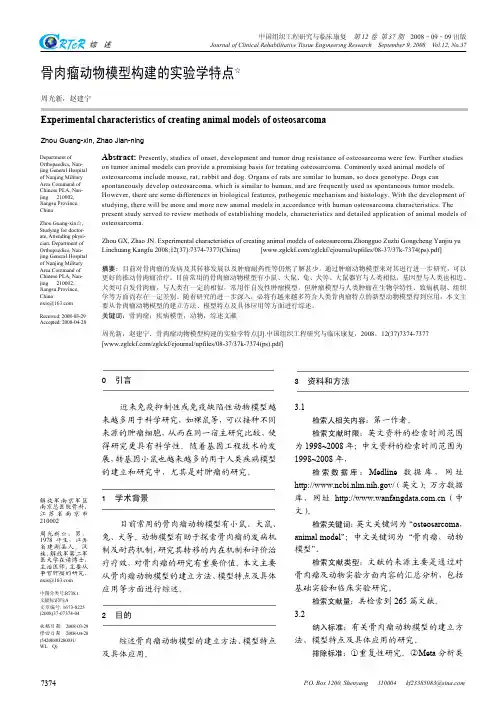
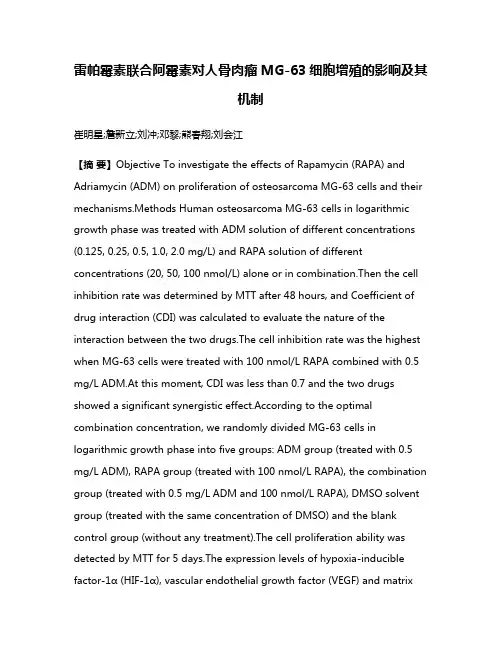
雷帕霉素联合阿霉素对人骨肉瘤MG-63细胞增殖的影响及其机制崔明星;詹新立;刘冲;邓黎;熊春翔;刘会江【摘要】Objective To investigate the effects of Rapamycin (RAPA) and Adriamycin (ADM) on proliferation of osteosarcoma MG-63 cells and their mechanisms.Methods Human osteosarcoma MG-63 cells in logarithmic growth phase was treated with ADM solution of different concentrations (0.125, 0.25, 0.5, 1.0, 2.0 mg/L) and RAPA solution of different concentrations (20, 50, 100 nmol/L) alone or in combination.Then the cell inhibition rate was determined by MTT after 48 hours, and Coefficient of drug interaction (CDI) was calculated to evaluate the nature of the interaction between the two drugs.The cell inhibition rate was the highest when MG-63 cells were treated with 100 nmol/L RAPA combined with 0.5 mg/L ADM.At this moment, CDI was less than 0.7 and the two drugs showed a significant synergistic effect.According to the optimal combination concentration, we randomly divided MG-63 cells in logarithmic growth phase into five groups: ADM group (treated with 0.5 mg/L ADM), RAPA group (treated with 100 nmol/L RAPA), the combination group (treated with 0.5 mg/L ADM and 100 nmol/L RAPA), DMSO solvent group (treated with the same concentration of DMSO) and the blank control group (without any treatment).The cell proliferation ability was detected by MTT for 5 days.The expression levels of hypoxia-inducible factor-1α (HIF-1α), vascular endothelial growth factor (VEGF) and matrixmetalloproteinase 2 (MMP-2) mRNA were analyzed by real-time PCR at 48 h.Results There was no significant difference in cell proliferation ability among these groups on day 1 and 2 (all P>0.05).The cell proliferation ability of the combination group was lower than those of the blank control group, DMSO solvent group, ADM group and RAPA group on day 3-5 (all P<0.05).The relative expression of HIF-1α, VEGF and MMP-2 mRNA in the combination group was significantly lower than that in the blank control group, DMSO solvent group, ADM group and RAPA group (allP<0.05).Conclusion RAPA combined with ADM may synergistically inhibit the proliferation of human osteosarcoma MG-63 cells by decreasing the expression of HIF-1α, VEGF, MMP-2 mRNA.%目的探讨雷帕霉素联合阿霉素对人骨肉瘤MG-63细胞(以下称骨肉瘤细胞)增殖的影响及其作用机制.方法取对数生长期骨肉瘤细胞,分别加入不同浓度的阿霉素(0.125、0.25、0.5、1.0、2.0mg/L)和雷帕霉素(20、50、100 nmol/L)单独及联合作用,采用MTT法检测作用48 h的细胞增殖抑制率,并计算两药相互作用指数(CDI),评价两药相互作用性质.结果以100 nmol/L雷帕霉素与0.5 mg/L 阿霉素联合作用后的细胞增殖抑制率最高,此时CDI<0.7,两种药物表现为显著协同作用.将对数生长期的骨肉瘤细胞分为五组,阿霉素组、雷帕霉素组分别加入0.5 mg/L阿霉素、100 nmol/L雷帕霉素,联合用药组加入0.5 mg/L阿霉素和100 nmol/L雷帕霉素,DMSO溶媒组加入等量DMSO,空白对照组不予处理.采用MTT法检测各组细胞增殖能力,连续记录5天.采用Real-time PCR法检测各组处理48 h缺氧诱导因子1α(HIF-1α)、血管内皮生长因子(VEGF)、基质金属蛋白酶2(MMP-2) mRNA 相对表达量.结果各组作用第1、2天细胞增殖能力比较差异均无统计学意义(P均>0.05).作用第3~5天,联合用药组细胞增殖能力均明显低于空白对照组、DMSO溶媒组、阿霉素组及雷帕霉素组(P均<0.05).联合用药组HIF-1α、VEGF、MMP-2 mRNA相对表达量均明显低于空白对照组、DMSO溶媒组、阿霉素组、雷帕霉素组(P均<0.05).结论雷帕霉素联合阿霉素可以协同抑制骨肉瘤细胞增殖;降低HIF-1α、VEGF、MMP-2表达可能是其作用机制.【期刊名称】《山东医药》【年(卷),期】2017(057)016【总页数】4页(P8-11)【关键词】骨肉瘤;细胞增殖;雷帕霉素;阿霉素;药物敏感性【作者】崔明星;詹新立;刘冲;邓黎;熊春翔;刘会江【作者单位】新乡医学院第一附属医院,河南新乡453100;广西医科大学第一附属医院;广西医科大学第一附属医院;广西医科大学第一附属医院;广西医科大学第一附属医院;广西医科大学第一附属医院【正文语种】中文【中图分类】R738.1骨肉瘤是一种好发于长骨干骺端的原发性恶性肿瘤,在青少年人群中多发。
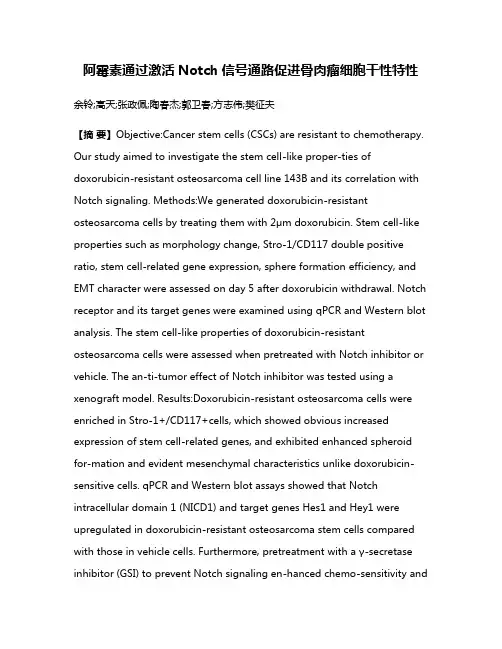
阿霉素通过激活Notch信号通路促进骨肉瘤细胞干性特性余铃;高天;张政佩;陶春杰;郭卫春;方志伟;樊征夫【摘要】Objective:Cancer stem cells (CSCs) are resistant to chemotherapy. Our study aimed to investigate the stem cell-like proper-ties of doxorubicin-resistant osteosarcoma cell line 143B and its correlation with Notch signaling. Methods:We generated doxorubicin-resistant osteosarcoma cells by treating them with 2μm doxorubicin. Stem cell-like properties such as morphology change, Stro-1/CD117 double positive ratio, stem cell-related gene expression, sphere formation efficiency, and EMT character were assessed on day 5 after doxorubicin withdrawal. Notch receptor and its target genes were examined using qPCR and Western blot analysis. The stem cell-like properties of doxorubicin-resistant osteosarcoma cells were assessed when pretreated with Notch inhibitor or vehicle. The an-ti-tumor effect of Notch inhibitor was tested using a xenograft model. Results:Doxorubicin-resistant osteosarcoma cells were enriched in Stro-1+/CD117+cells, which showed obvious increased expression of stem cell-related genes, and exhibited enhanced spheroid for-mation and evident mesenchymal characteristics unlike doxorubicin-sensitive cells. qPCR and Western blot assays showed that Notch intracellular domain 1 (NICD1) and target genes Hes1 and Hey1 were upregulated in doxorubicin-resistant osteosarcoma stem cells compared with those in vehicle cells. Furthermore, pretreatment with a γ-secretase inhibitor (GSI) to prevent Notch signaling en-hanced chemo-sensitivity andinhibited doxorubicin-enriched osteosarcoma stem cell activity in vitro. Finally, the Notch inhibitor pre-vented tumor growth in mice xenograft models. Conclusion: Doxorubicin induced the enrichment of osteosarcoma stem-like cells through Notch signaling, and inactivation of Notch could be useful for overcoming drug resistance and eliminating osteosarcoma.%目的:骨肉瘤干细胞具有化疗耐药性.本文拟探讨耐阿霉素细胞干细胞样特性的改变,以及Notch通路在其中的调控作用.方法:采用2μM的阿霉素处理骨肉瘤细胞143B 24 h,去药继续培养5 d,检测干细胞样特性的改变,包括形态学的改变、Stro-1+/CD117+双阳性细胞比例、干细胞相关基因表达、悬浮成球的能力、EMT特性.qPCR及Western blot检测Notch通路受体及靶基因表达情况.利用Notch抑制剂DAPT预处理,检测其对耐阿霉素骨肉瘤细胞的干细胞样特性的影响.构建裸鼠移植瘤模型,检测Notch抑制剂对体内成瘤的影响.结果:耐阿霉素骨肉瘤细胞中Stro-1+/CD117+比例增高,干细胞相关基因Oct4、Sox2表达量增加,悬浮成球能力增强,EMT特性上调.qPCR及Western blot结果显示阿霉素耐药的骨肉瘤细胞中Notch受体胞内段NICD1及靶基因Hes1、Hey1等表达量上调.Notch信号抑制剂能够增强骨肉瘤对阿霉素的化疗敏感性,抑制体外阿霉素对骨肉瘤干细胞的富集作用.动物实验表明,Notch抑制剂DAPT能够抑制体内成瘤.结论:阿霉素能够富集骨肉瘤干细胞,Notch信号通路参与其中调控机制,抑制Notch通路能够靶向杀伤骨肉瘤细胞,增加化疗药物敏感性.【期刊名称】《中国肿瘤临床》【年(卷),期】2017(044)011【总页数】5页(P527-531)【关键词】阿霉素;骨肉瘤;Notch信号通路;肿瘤干细胞【作者】余铃;高天;张政佩;陶春杰;郭卫春;方志伟;樊征夫【作者单位】武汉大学人民医院骨1科武汉市430060;北京大学肿瘤医院暨北京市肿瘤防治研究所骨与软组织肿瘤科,恶性肿瘤发病机制及转化研究教育部重点实验室;武汉大学人民医院骨1科武汉市430060;武汉大学人民医院骨1科武汉市430060;武汉大学人民医院骨1科武汉市430060;北京大学肿瘤医院暨北京市肿瘤防治研究所骨与软组织肿瘤科,恶性肿瘤发病机制及转化研究教育部重点实验室;北京大学肿瘤医院暨北京市肿瘤防治研究所骨与软组织肿瘤科,恶性肿瘤发病机制及转化研究教育部重点实验室【正文语种】中文骨肉瘤是最常见的原发恶性骨肿瘤,好发于青少年。

骨肉瘤动物模型的研究进展【摘要】实验动物模型是研究人类骨肉瘤的重要手段之一。
动物模型有多种不同建立方法。
全文对动物模型的建立方法、模型特点及目前应用等进行综述。
【关键词】骨肉瘤骨肉瘤好发于青少年,是导致青少年死亡的第二大恶性肿瘤。
至今对骨肉瘤的病因及其转移发展机制仍了解甚少。
可以通过肿瘤动物模型来对其进行进一步研究,目前常用的动物模型有小鼠、大鼠、兔、犬等。
大鼠器官与人类相似,基因型与人类也相近。
犬类可自发骨肉瘤,与人类有一定的相似,常用作自发性肿瘤模型。
近来流行免疫抑制性或免疫缺陷性动物模型,如裸鼠等,可以接种不同来源的肿瘤细胞,从而在同一宿主研究比较。
动物模型有助于探索骨肉瘤的发病机制,研究其转移的内在机制和评价治疗疗效,对骨肉瘤的研究有重要价值。
本文主要从骨肉瘤动物模型的建立方法、模型特点及具体应用等方面进行综述。
1 动物模型建立方法1.1 诱发型肿瘤模型系将致癌物质与动物特定部位直接或间接接触,使该部位靶器官产生肿瘤。
其操作相对简单,靶器官和诱癌剂恒定,成瘤率较高,是一种较好的建立肿瘤模型的方法。
但诱发肿瘤形成需要较长时间,且诱发肿瘤的恶性程度不高,低分化肿瘤少见。
物理因素诱导:放射性核素是强致癌物质,将核素与动物接触,可以诱发骨肉瘤。
原子序数大于铀的核素,如238钚、351镅等是强致癌物。
放射性核素诱导骨肉瘤可将核素的盐溶液注射到动物体内,也可直接用核素对动物进行照射。
用核素盐溶液诱导肿瘤时,剂量应适宜,过低不易致瘤,过高时核素对肿瘤细胞有杀伤作用,会导致实验失败。
王玉民等[1]以Wistar大鼠为研究对象,利用发射性超铀核素238钚作为物理致癌因子在大鼠体内诱发肿瘤。
他们将硝酸238钚溶液释后,以不同剂量注射于大鼠臀肌内,发现随着盐溶液浓度的增加,骨肉瘤的发生率也随之上升,但当剂量增加到一定程度时,骨肉瘤的发生率反而下降。
Tinkey PT 等[2]以Sprague-Dawlev大鼠为研究对象,用60Co以致瘤累积剂量照射其后腿4~8个月,观察到大剂量照射的大鼠发生了骨肉瘤及其他肿瘤,低剂量照射的大鼠则未发生肿瘤。
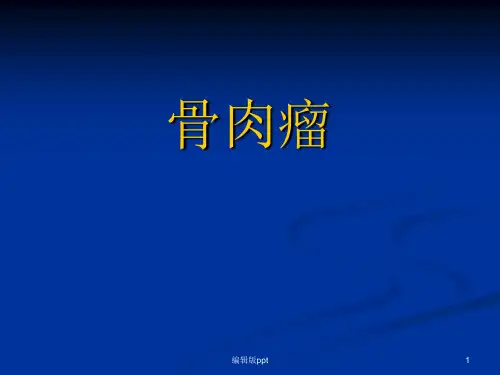
・实验研究・阿霉素冲击诱导人骨肉瘤多药耐药细胞模型曾 恒 杨彩虹 陈安民 摘 要 目的:建立人骨肉瘤细胞多药耐药亚系。
方法:采用ADM 间断冲击法诱导骨肉瘤细胞,并用免疫荧光、M TT 及ABA 法检测肿瘤细胞的耐药特征。
结果:本实验建立了6株多药耐药细胞亚系M G 263/R 1~6。
用免疫荧光术可以检测到P 2gp 的表达,M TT 、ABA 法显示各亚系细胞的多药耐药性明显增加,并且维拉帕米可以拮抗P 2gp 的作用。
结论:MDR1/P 170在多药耐药的特性上起着至关重要的作用,而且这些骨肉瘤多药耐药细胞亚系为进一步研究骨肉瘤耐药特征及逆转方法打下基础。
关键词 骨肉瘤; 多药耐药; 细胞模型; 阿霉素中图分类号 R687 文献标识码 A 文章编号 1005-8478(2003)05-0318-03Experiment Models for the Study of MDR :H um an Osteosarcom a C ell Sublines ∥ZEN G Heng ,YA N G Cai 2hong ,CHENA n 2min.Orthopaedic Depart ment of Tongji Hospital.Tongji Medical College of Huaz hong U niversity of Science and Technol 2ogy ,W uhan 430030Abstract Objective :To establish a multidrug 2resistene (MDR )subline of human osteosarcoma.Methods :The authors cre 2ated cell lines by short 2time pulse exposure of the parent cell line to adriamycin followed by single 2cell clone.MDR character was detected with immunoflorescence method and M TT ,ABA Results :The authors developed six P 2gp 2positive ,human osteosarcoma cell lines that were resistant to adriamycin M G 263/R 1~6which were higher than the cells from parent line respectively and also cross 2resistant to other drugs at different degrees.There was less accumulation of the drug in resistent cell lines ,AB %of M G 263/R 6is only 9.8%.but when verapamil is used ,AB %could risen to 52%.Immunoflorescence can detect significant high ex 2pression of P 2gp in MDR cell lines.Conclusion :Expression of MDR1/P 170is key factor to regulate MDR phenotype of osteosarco 2ma.These newly described multidrug 2resistent osteosarcoma cell sublines are useful models for further characterization of drug resistence in osteosarcoma and for the development of treatment protocols.K ey w ords Osteosarcoma ; Multidrug 2resistance ; Cell 2model ; Adriamycin (ADM )作者单位:同济医学院附属同济医院矫形外科,武汉 430030作者简介:曾恒(19732),男,博士研究生,主治医生。
依维莫司增强阿霉素抑制骨肉瘤干细胞的作用张斌;杨微;贺宝霞;杜娟;于卫江;林晓贞;田锋奇【摘要】背景:阿霉素能够抑制骨肉瘤细胞的增殖,但是阿霉素对骨肉瘤干细胞的作用以及依维莫司联合阿霉素对骨肉瘤干细胞的作用未见报道.目的:研究mTOR通路抑制剂依维莫司联合骨肉瘤化疗一线药物阿霉素对骨肉瘤干细胞增殖及侵袭的影响.方法:用免疫磁珠分选法分离人骨肉瘤细胞株MG63中的CD133+骨肉瘤干细胞.MTT检测0,0.1,0.2,0.4 mg/L阿霉素以及0.2 mg/L阿霉素+20 μmol/L依维莫司对骨肉瘤干细胞增殖的影响.Transwell小室检测0.2 mg/L阿霉素和0.2mg/L阿霉素+20 μmol/L依维莫司对骨肉瘤干细胞侵袭的影响.Western Blot检测0.2 mg/L阿霉素和0.2 mg/L阿霉素+20 μmol/L依维莫司对骨肉瘤干细胞增殖细胞核抗原、基质金属蛋白酶蛋白表达的影响.结果与结论:①阿霉素能在一定质量浓度下抑制骨肉瘤干细胞的增殖,且依维莫司联合阿霉素较单独使用阿霉素时明显抑制骨肉瘤干细胞的增殖,说明依维莫司能够增强阿霉素对骨肉瘤干细胞增殖的抑制作用;②与单独使用阿霉素比较,依维莫司联合阿霉素作用于骨肉瘤干细胞后侵袭细胞数明显减少;③依维莫司联合阿霉素显著抑制骨肉瘤干细胞增殖细胞核抗原、基质金属蛋白酶蛋白的表达,提示依维莫司能够增强阿霉素抑制骨肉瘤干细胞增殖与侵袭的能力.【期刊名称】《中国组织工程研究》【年(卷),期】2019(023)005【总页数】5页(P663-667)【关键词】依维莫司;阿霉素;MG63;骨肉瘤干细胞;增殖;侵袭;增殖细胞核抗原;基质金属蛋白酶9;干细胞【作者】张斌;杨微;贺宝霞;杜娟;于卫江;林晓贞;田锋奇【作者单位】郑州大学附属肿瘤医院/河南省肿瘤医院药学部,河南省郑州市450003;郑州大学附属肿瘤医院/河南省肿瘤医院药学部,河南省郑州市450003;郑州大学附属肿瘤医院/河南省肿瘤医院药学部,河南省郑州市450003;郑州大学附属肿瘤医院/河南省肿瘤医院药学部,河南省郑州市450003;郑州大学附属肿瘤医院/河南省肿瘤医院药学部,河南省郑州市450003;郑州大学附属肿瘤医院/河南省肿瘤医院药学部,河南省郑州市450003;郑州大学附属肿瘤医院/河南省肿瘤医院药学部,河南省郑州市450003【正文语种】中文【中图分类】R459.9;R394.2文章快速阅读:文题释义:干细胞表面标志物CD133:是一种独特的干细胞标志,分子质量为120 ku。
载阿霉素壳聚糖纳米粒子可抑制小鼠骨肉瘤李永恒;崔岩;张治宇【摘要】背景:近来大量研究证明,纳米载体系统可实现药物在肿瘤组织定点释放或激活,提高局部药物浓度,减少正常组织的药物蓄积,降低不良反应.目的:分析载阿霉素壳聚糖纳米粒子的细胞毒性及对骨肉瘤的抑制作用.方法:①细胞毒性实验:采用含载阿霉素壳聚糖纳米粒子(简称载药纳米微粒)的PBS与含游离阿霉素的PBS分别干预鼠源骨肉瘤细胞系K7(均设置0.16,0.31,0.62,1.25,2.5,5,10 mg/L 7个质量浓度),干预24,72 h后,采用MTT法检测细胞存活率;②体内药物分布实验:皮下注射鼠源骨肉瘤细胞系K7建立Balb/c小鼠(长春生物制品研究所有限责任公司提供)肿瘤模型,当肿瘤体积达到200 mm3时,实验组、对照组分别尾静脉注射含载药纳米微粒的PBS与含游离阿霉素的PBS;注射后6,12 h处死小鼠,观察各脏器阿霉素荧光;③体内抑瘤实验:皮下注射鼠源骨肉瘤细胞系K7建立Balb/c小鼠肿瘤模型,当肿瘤体积达到50 mm3时,实验组、对照组分别尾静脉注射含载药纳米微粒的PBS与含游离阿霉素的PBS,空白组注射PBS,4 d注射1次,共6次,每天检测小鼠体质量与肿瘤体积.动物实验方案经吉林大学动物实验中心伦理委员会批准.结果与结论:①药物作用24 h时,载药纳米微粒与游离阿霉素杀伤骨肉瘤细胞的半数致死率质量浓度分别为2.4,4.2 mg/L;72 h时,载药纳米微粒与游离阿霉素杀伤骨肉瘤细胞的半数致死率质量浓度分别为0.29,0.91 mg/L;②载药纳米微粒主要在肝脏、肾脏和肿瘤部位富集;③治疗周期内,实验组平均肿瘤体积明显小于对照组、空白组(P<0.001),实验组平均体质量大于对照组(P<0.001);④结果表明,该载药体系可很好地实现阿霉素体内外控制释放,明显提高化疗药物对骨肉瘤的抑制能力.【期刊名称】《中国组织工程研究》【年(卷),期】2019(023)026【总页数】6页(P4194-4199)【关键词】骨肉瘤;阿霉素;壳聚糖;纳米微粒;多糖;药物控制释放;纳米系统;肿瘤抑制【作者】李永恒;崔岩;张治宇【作者单位】中国医科大学附属第四医院,辽宁省沈阳市 110032;中国医科大学附属第四医院,辽宁省沈阳市 110032;中国医科大学附属第四医院,辽宁省沈阳市110032【正文语种】中文【中图分类】R453.9;R3130 引言 Introduction骨肉瘤是好发于儿童和青少年的原发性骨恶性肿瘤[1-2],单纯手术治疗的患者5年生存率低,仅20%左右[3-4]。
抗人成骨肉瘤单克隆抗体的制备及其特性李宏伟;王金成;卜丽莎;段德生;施建胜【期刊名称】《吉林大学学报(医学版)》【年(卷),期】2004(030)004【摘要】目的:制备抗人成骨肉瘤单克隆抗体并探讨其特性.方法:用人骨肉瘤细胞系OS-732免疫BALB/c小鼠,取其脾细胞与骨髓瘤细胞系NS-1融合,经酶联免疫吸附试验及补体依赖细胞毒实验筛选,获3株分泌抗人成骨肉瘤单克隆抗体(McAb)的杂交瘤细胞.将手术切取经病理证实的骨肉瘤、软骨肉瘤、骨巨细胞瘤、滑膜肉瘤、平滑肌肉瘤、非骨化性纤维瘤、骨软骨瘤和正常肌、骨组织冰冻切片后,应用间接免疫荧光抗体实验检测.结果:3株McAb均与骨肉瘤组织呈阳性反应,其中二株亦与软骨肉瘤呈阳性反应,与正常组织及其他肿瘤组织呈阴性反应.株McAb分别与骨肉瘤相关抗原不同的抗原决定簇结合.结论:抗人成骨肉瘤单克隆抗体具有较高的特异性.【总页数】3页(P559-561)【作者】李宏伟;王金成;卜丽莎;段德生;施建胜【作者单位】吉林大学中日联谊医院骨科,吉林,长春,130031;吉林大学中日联谊医院骨科,吉林,长春,130031;吉林大学中日联谊医院中心实验室,吉林,长春,130031;吉林大学中日联谊医院中心实验室,吉林,长春,130031;吉林大学中日联谊医院骨科,吉林,长春,130031【正文语种】中文【中图分类】R392.11;R-332【相关文献】1.甲氨蝶呤与抗人成骨肉瘤单克隆抗体F(ab')2片段偶联物的体外抗肿瘤作用 [J], 詹新立;肖增明;李世德;周江南2.抗人成骨肉瘤杂交瘤细胞系的建立及单克隆抗体特性 [J], 何大为;张惠中;范清宇;裘秀春;马保安;周勇;刘明3.抗人成骨肉瘤单克隆抗体对人骨肿瘤定位显像研究 [J], 陈永裕;高建章;赵杰;陈舰;王秋根;沈茜;徐登仁;刘振华4.与顶体反应相关的抗人精子单克隆抗体及其抗原的特性Ⅰ顶体反应的诱导及抗顶体反应精子的单克隆抗体的制备 [J], 王云美;贲昆龙;曹筱梅5.抗人Ig轻链系列单克隆抗体的研制1.抗人λ轻链亚型/亚群单克隆抗体的制备及特性鉴定 [J], 赵蓉;郑志竑;谢捷明;包少佳;吴国华;邱文萱因版权原因,仅展示原文概要,查看原文内容请购买。
143B人骨肉瘤细胞说明书及注意事项1.简介:143B人骨肉瘤细胞是胸腺激酶缺陷骨肉瘤细胞株。
在本库通过支原体检测。
在本库通过STR检测。
所有肿瘤细胞和病毒转染的细胞均视为有潜在的生物危害性,必须在二级生物安全台内操作,操作者需注意自身防护。
基本培养条件:培养基:90%MEM+10%胎牛血清温度:37℃气相:95%空气,5%二氧化碳2.细胞运输:本细胞为贴壁细胞,常规运输方式是将细胞在培养瓶中培养至状态良好后灌满新鲜的完全培养液并封好瓶口进行运输。
根据气温的高低及运输距离的远近,我们可能采取以下两种方式运输。
活细胞胰酶消化离心后血清发货;冻存管发货。
3.客户收到细胞后请严格按照以下要求进行操作。
3.1培养前的注意事项:A. 细胞出库前都是生长良好,我们会对出库细胞进行拍照留档(建议用户在收到细胞时拍照片,细胞拍照时请用100X 、200X倍数各拍上2~3张照片留存,可用作细胞状态的对比,拍摄的照片应当清晰)。
B. 用户在收到细胞后,先观察培养瓶是否完好,培养液是否外渗,培养液是否浑浊。
3.2新购细胞的初步培养:客户收到细胞后在未开封前,先用75%酒精将培养瓶外表擦拭干净,镜检细胞贴壁情况。
将细胞置于培养箱中进行1-2小时的缓冲,待细胞恢复基本生长状态后,进行后续细胞实验。
细胞恢复基本生长状态后,倒置显微镜下观察整个细胞生长情况:A. 细胞密度未达85%时,用75%酒精喷洒培养瓶后放在生物操作台内,严格无菌操作,打开细胞培养瓶,吸取剩余培养液,只留6~8ml培养液继续培养。
B.细胞长满(达85-95%),即可进行传代。
3.3细胞培养:A.细胞密度未达85%时,5~8ml培养液继续培养。
B.培养基营养耗尽时,需及时换新鲜培养基;C.细胞长满(达85-95%),即可进行传代。
传代参考步骤如下:a.弃去培养液,用无钙镁D-PBS洗涤1-2次b.对于T25培养瓶来说,加入2-3ml 0.25%的胰酶-EDTA消化液,置37℃消化,并不时用显微镜观察细胞消化情况,如细胞回锁变圆、透亮、轻拍瓶壁呈流沙样脱落,则迅速回操作台,加入6-8ml含10%血清的完全培养液,终止消化并轻轻吹打细胞,使其变成单细胞悬液。
中国组织工程研究与临床康复第 15卷第 37期 2011– 09– 10出版Journal of Clinical Rehabilitative Tissue Engineering Research September 10, 2011 Vol.15, No.37 ISSN 1673-8225 CN 21-1539/R CODEN: ZLKHAH6913 1Department of Orthopedics, Ninth People’s Hospital of Chongqing,Chongqing 400700, China; 2Department of Orthopedics,Second Affiliated Hospital ofChongqing Medical University,Chongqing 40010, ChinaChen Yu☆ , Doctor, Attending physician, Department of Orthopedics, Ninth People’s Hospital of Chongqing,Chongqing 400700, Chinachenyu@ Correspondence to: Deng Zhong-liang, Doctor, Professor, Department of Orthopedics, Second Affiliated Hospital of Chongqing Medical University,Chongqing 40010, Chinadeng7586@gmail. comSupported by: the National NaturalScience Foundation of China, No.30772211*Received: 2011-06-10 Accepted: 2011-07-30人骨肉瘤耐阿霉素细胞模型的建立及其生物学特性 *☆陈渝 1,王大勇 1,翁政 1,邓忠良 2Establishment of adriamycin-resistant human osteosarcoma cell line and research on its biological characteristicsChen Yu1, Wang Da-yong1, Weng Zheng1, Deng Zhong-liang2AbstractBACKGROUND: Multidrug resistance is a major factor leading to the failure of chemotherapy for human osteosarcoma. However,the precise mechanism remains poorly understood.OBJECTIVE: To establish adriamycin-resistant human osteosarcoma cell line143B/ADM and to analyze its biological characteristics.METHODS: Increasing concentrations of adriamycin (ADM were applied for 45 days to establish 143B/ADM resistant strain. Thehalf of inhibiting concentrations (IC50 and resistance indexs (RI of different antitumor drugs were measured by CCK assay, andthe cell cycle was analyzed by flow cytometry. The cellular efflux capacity was estimated by rhodamine test. After the cell lineswere treated by ADM, intracellular ADM concentration was detected by fluorospectrophotometer, and the apoptosis wasobserved by laser scanning confocal microscope and flow cytometry. Meanwhile, the expression of multidrug resistance 1(MDR-1, multidrug resistance-associated protein 1 (MRP-1 and lung resistance protein (LRP were detected by western blotanalysis.RESULTS AND CONCLUSION: After induction for 45 days, the RI of 143B/ADM cells to ADM was 15.7, and the 143B/ADM cellsshowed various resistances to cisplatin, methotrexate, isophosphamide, vincristine and taxinol. Compared with 143B/WT cell line,there were less cells in G2/M phase and more cells in G1 and S phases, markedly decreased intracellular rho123 and ADM in143B/ADM cell line (P < 0.01. Flow cytometry and confocal laser microscopy analysis showed that at 72 hours after treatmentwith ADM (10 mg/L, cell apoptosis in 143B/ADM cells was less than that in143B/WT cells. Furthermore, compared with143B/WT, the MDR-1 expression of 143B/ADM was increased significantly with no difference of MRP-1 and LRP expressionamong both cell lines. Multidrug resistance of 143B/ADM cells is related to MDR-1, and has no relationship with MRP-1 and LRP.Chen Y, Wang DY, Weng Z, Deng ZL.Establishment of adriamycin-resistant human osteosarcoma cell line and research on itsbiological characteristics. Zhongguo Zuzhi Gongcheng Yanjiu yu Linchuang Kangfu. 2011;15(37: 6913-6918.[ ]摘要背景:多药耐药是骨肉瘤化疗失败的重要原因,目前其耐药机制不明。
目的:诱导建立耐阿霉素的人骨肉瘤细胞株并观察多药耐药蛋白 1、多药耐药相关蛋白 1和肺耐药蛋白的表达。
方法:采用逐步递增阿霉素浓度间歇作用的方法诱导 143B/WT细胞株建立143B/阿霉素耐药细胞株。
结果与结论:经阿霉素诱导 45 d建立了 143B/阿霉素细胞株,其对阿霉素高度耐药,对顺铂、甲氨蝶呤、异环磷酰胺、长春新碱和紫杉醇亦产生不同程度交叉耐药;流式细胞仪检测显示与 143B 野生型细胞相比, 143B/阿霉素细胞周期中 G 1和 S 期所占比例增加,而 G 2/M期所占比例明显减少;罗丹明外排实验显示, 143B/阿霉素细胞药物外排能力显著高于143B/WT细胞 (P < 0.01;流式细胞仪和激光共聚焦显微镜观察发现, 143B/阿霉素细胞阿霉素相关性细胞凋亡率显著低于 143B/WT(P < 0.01; Western blot检测显示 143B/阿霉素细胞多药耐药蛋白 1表达水平较 143B/WT显著升高 (P < 0.01,二者多药耐药相关蛋白 1和肺耐药蛋白表达差异无显著性意义 (P > 0.05。
提示143B/阿霉素细胞多药耐药的产生与多药耐药蛋白 1表达升高相关。
关键词:骨肉瘤;阿霉素;多药耐药;多药耐药蛋白 1;细胞模型doi:10.3969/j.issn.1673-8225.2011.37.018陈渝,王大勇,翁政,邓忠良 . 人骨肉瘤耐阿霉素细胞模型的建立及其生物学特性[J].中国组织工程研究与临床康复, 2011, 15(37:6913-6918. [ ]0 引言多药耐药现象是由一种化疗药物诱发,肿瘤组织对该药产生耐药的同时对其他结构和功能无关的化疗药物产生交叉耐药的现象。
多药耐药的发生是影响肿瘤患者化疗效果、预后的主要因素之一 [1-2]。
多药耐药 (multidrug resistance, MDR蛋白 1(MDR-1、多药耐药相关蛋白 1(multidrug resistance-associated protein 1, MRP-1和肺耐药蛋白 (lung resistance protein, LRP是多药耐药基因编码的主要产物。
研究发现, MRP-1、 LRP 和 MDR-1在多种耐药性肿瘤中表达升高,其表达水平与肿瘤耐药性密切相关 [3-5]。
实验拟采取阿霉素 (doxorubicin, ADM为诱导药物,以人骨肉瘤细胞株 143B 为研究对象,采用逐步递增 ADM 浓度间歇作用方法建立人骨肉瘤多药耐药细胞株,并初步探讨其耐药机制。
万方数据陈渝,等 . 人骨肉瘤耐阿霉素细胞模型的建立及其生物学特性P.O. Box 1200, Shenyang 110004 6914www. CRTER .org1重庆市第九人民医院骨科,重庆市 400700; 2重庆医科大学附属第二医院骨科,重庆市 400010陈渝☆,男, 1977年生,四川省资阳市人,汉族, 2011年重庆医科大学毕业,博士,主治医师,主要从事骨肿瘤耐药机制的研究。